You’re probably headed to bed as we’re starting our day. It’s cloudy and about 60 degrees this morning. I think most people think of ‘Africa’ and think hot hot hot. Certainly those hot temperatures are possible, especially with climate change. But it’s been lovely and cool here at the base of Kilimanjaro, with cloudy skies, seventy-degree days, and no real rain. The clouds have been hiding Mount Kilimanjaro since the students arrived. The locals say Kili is shy. But last evening, the awe and wonder of Kili hit the students as she finally broke through the clouds and they got their first 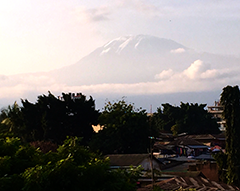 real view of her. It’s a magnificent sight.
real view of her. It’s a magnificent sight.
We did our slow ramp up here, and gave the students a gradual introduction to Tanzania with a day of wandering around Moshi town to get them oriented. Wandering is appropriate, because in Swahili, white people are called ‘Mzungu’ – which directly translated means ‘wanderer.’ Paul, one of our faculty on the trip, was reading the origin of the word. From the lore, it sounds like white people would come to East Africa and get lost, so they’d wander around. Hence the term ‘wanderer.’ Katelyn, one of our students, found a different origin of the word. According to her source, ‘Mzungu’ comes from a Maasai word that means ‘men who can smell their own farts.’ Because white people wear pants, it traps the gas in so you can smell it – which is a little crazy to the Maasai. Why not just put on a blanket and call it good?
 Speaking of Maasai blankets, the students are all sleeping cozily under Maasai blankets since last I wrote. My aggressive insistence paid off. We will be losing no fingers or toes to frostbite on this trip.
Speaking of Maasai blankets, the students are all sleeping cozily under Maasai blankets since last I wrote. My aggressive insistence paid off. We will be losing no fingers or toes to frostbite on this trip.
Our second day of orientation involved getting the students out of Moshi. Paul and the drivers took them to the maji moto (hot springs). This little oasis in the desert is a favorite spot of our students. They do back flips off the rope swing, and let the little fish in the pool eat the dead skin off their feet. Yes, pedicure – Tanzania style. This years students had the advantage of having Paul along, who is fairly expert at herbal medicine. He walked them through the foliage around the springs and helped them identify the medicinal plants. Lots of anti-anxiolytics, I’m told. Great – so there are two forms of relaxation: a beautiful pool of amazing warm water, and relaxation-inducing herb to chew on while you soak!
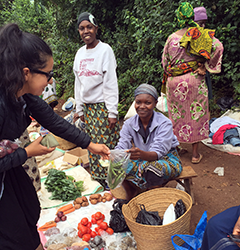 On the way to the hot springs, the Tanzanian landscape is filled with farms. The small local farms have fields full of dead corn right now. They didn’t get enough water this year, and the corn didn’t survive. Interestingly, immediately adjacent to these fields are fields filled with thriving corn. These fields are owned by DeKalb and Monsanto – and are irrigated. That’s one of the advantages of having money and power. It means you get the water. But it also means that no one will go hungry around here. Some of the students wanted to get into the GMO debate. I just gave them my best Mona Lisa smile… Best not to get into arguments when you’re going to be spending 21 days with someone.
On the way to the hot springs, the Tanzanian landscape is filled with farms. The small local farms have fields full of dead corn right now. They didn’t get enough water this year, and the corn didn’t survive. Interestingly, immediately adjacent to these fields are fields filled with thriving corn. These fields are owned by DeKalb and Monsanto – and are irrigated. That’s one of the advantages of having money and power. It means you get the water. But it also means that no one will go hungry around here. Some of the students wanted to get into the GMO debate. I just gave them my best Mona Lisa smile… Best not to get into arguments when you’re going to be spending 21 days with someone.
We saw the same dichotomy as we headed to ChildReach International to visit schools the next day. After passing some dead beans, we passed miles and miles of thriving sugar cane. The irrigation ditches reminded me of the old Roman water systems, with metal plates to divert water from one ditch to another. The sugar cane industry supports whole towns in northern Tanzania. Interestingly, most of the sugar is exported, and then the Tanzanians have to buy it back from the Europeans at a greater expense. There’s hope that the new president might change this practice so that a larger percentage is sold locally.
Out beyond the sugar cane fields is a remote village with dozens of mud huts, and a beautiful view of the mountains that have the Tanzanite mines. The only colorful building in town is the school. Painted bright lime green, the school is the product of ChildReach International. This amazing organization goes into the impoverished areas, and renovates classrooms, provides books, food, and school supplies, and removes obstacles to kids going to school.
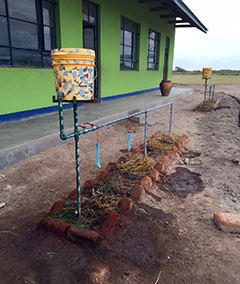 We visited two schools that they’ve improved, and the results are amazing. Here you can truly see ingenuity in process. For example, with just a bucket, a pipe, and net bags with soap inside, some German engineers designed a water system so that the kids can wash their hands. It doesn’t require running water, and only costs about $150 to install. The kids sing a song while they wash their hands so they know how long to wash. I think we could do something similar. It could make public restrooms much more fund. Can you imagine walking into a public restroom and having everyone at the sink singing T-Swift – Shake it Off?
We visited two schools that they’ve improved, and the results are amazing. Here you can truly see ingenuity in process. For example, with just a bucket, a pipe, and net bags with soap inside, some German engineers designed a water system so that the kids can wash their hands. It doesn’t require running water, and only costs about $150 to install. The kids sing a song while they wash their hands so they know how long to wash. I think we could do something similar. It could make public restrooms much more fund. Can you imagine walking into a public restroom and having everyone at the sink singing T-Swift – Shake it Off?
 Truthfully, the NUNM students were less into the public health projects and more into the kids. The kids at both schools welcomed them warmly. At the first school, the children sang a song for us. So my students sang back. One of my students had brought Frisbees – a totally foreign concept to these kids. So everyone played Frisbee together; some picked it up better than others. (Anyone who has seen me throw a Frisbee will be happy to know that I stood back and took pictures.) At the second school, our NUNM students were like celebrities. Children swarmed them, cheered for them, and held their hands.
Truthfully, the NUNM students were less into the public health projects and more into the kids. The kids at both schools welcomed them warmly. At the first school, the children sang a song for us. So my students sang back. One of my students had brought Frisbees – a totally foreign concept to these kids. So everyone played Frisbee together; some picked it up better than others. (Anyone who has seen me throw a Frisbee will be happy to know that I stood back and took pictures.) At the second school, our NUNM students were like celebrities. Children swarmed them, cheered for them, and held their hands.
I think the NUNM students forgot why they were at the school, and simply relaxed into being a playmate for the kids. One student commented that her face hurt from so much smiling. I’ll take a smile injury any day of the week.
Back in Moshi-town, we spent Thursday afternoon with the Duke Global Health Institute at Kilimanjaro Christian Medical College (KCMC). KCMC is the largest hospital in the region, and Duke has partnered with them to conduct some super-interesting projects. One project, run by Dorothy Dow, is implementing a mental health intervention for teens with HIV. This project recognizes that historically, there’s been a lot of stigma associated with an HIV diagnosis, and that it was a death sentence. However, with the anti-retrovirals available, teens can have productive lives. Because of the negative history, it’s important to help teens get on a positive path.
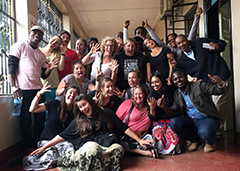 Another researcher, Catherine Staton, has a fascinating study addressing traumatic brain injuries from traffic accidents. Most frequently, these are happening with men who drive boda bodas (motorcycle taxis). She pointed out that traffic accidents are one of the few causes of death that have been rising over the past decades, and it’s mostly happening in countries with low economic resources. However, addressing this issue is complex because it involves everything from bad roads, no ambulance, no 911, a poorly equipped emergency room, to personal issues like alcoholism and not wearing helmets. Not an easy project, but definitely worthwhile.
Another researcher, Catherine Staton, has a fascinating study addressing traumatic brain injuries from traffic accidents. Most frequently, these are happening with men who drive boda bodas (motorcycle taxis). She pointed out that traffic accidents are one of the few causes of death that have been rising over the past decades, and it’s mostly happening in countries with low economic resources. However, addressing this issue is complex because it involves everything from bad roads, no ambulance, no 911, a poorly equipped emergency room, to personal issues like alcoholism and not wearing helmets. Not an easy project, but definitely worthwhile.
One of the classes our students take while they’re in Tanzania is Intro to Tropical disease. This class was enhanced by Duke’s Matt Rubach, who discussed his work on febrile illness (illnesses that have fevers associated with them). Because there’s not a lot of malaria in Moshi, it becomes a perfect place to study other tropical diseases that cause fever. Matt’s research shows that many of the fevers that come into KCMC are actually zoonotic – in other words, they’re coming from animals. This was unexpected, but if you think about it, this area is filled with farmers. So maybe it shouldn’t be a surprise. For Matt the bigger issue is that 50 percent of the deaths from fevers are from un-identified bacteria or viruses, even after he sent samples off to the CDC. Hmmmm. My students reapplied their bug-spray.
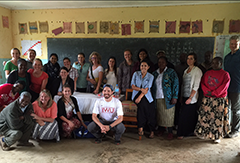 The week has ended with time in Mowo. Mowo is the village that our friend Eliphas introduced us to many years ago. It’s not that far from Moshi (maybe 15 or 20 miles), but it’s worlds away in other aspects. Mowo is somewhat lost in time. Cars don’t make it to Mowo – in fact one of our vehicles barely made it this year because the road was steep and muddy. Our students had to get out and walk the last bit. The village is connected by paths that run along the foothills of Kilimanjaro. You walk under banana, Eucalyptus, and Arcacia trees along steep trails up in the clouds to get anywhere. It’s absolute heaven.
The week has ended with time in Mowo. Mowo is the village that our friend Eliphas introduced us to many years ago. It’s not that far from Moshi (maybe 15 or 20 miles), but it’s worlds away in other aspects. Mowo is somewhat lost in time. Cars don’t make it to Mowo – in fact one of our vehicles barely made it this year because the road was steep and muddy. Our students had to get out and walk the last bit. The village is connected by paths that run along the foothills of Kilimanjaro. You walk under banana, Eucalyptus, and Arcacia trees along steep trails up in the clouds to get anywhere. It’s absolute heaven.
We brought textbooks and school supplies for the students of Mowo this year, and they were well received. We didn’t have as many textbooks as the school needed. In fact, we had less than 25 percent. But Joyce, the headmistress, was still thrilled. Better to have some textbooks than none at all. Then 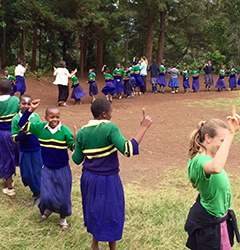 the NUNM students taught three different public health lectures to the Mowo 4th, 5th, and 6th, grades. At the end of the day, the NUNM students taught all of the kids the Hokey Pokey. It was awesome! Everyone was putting limbs into the giant circle on the Mowo soccer field and shaking them all about.
the NUNM students taught three different public health lectures to the Mowo 4th, 5th, and 6th, grades. At the end of the day, the NUNM students taught all of the kids the Hokey Pokey. It was awesome! Everyone was putting limbs into the giant circle on the Mowo soccer field and shaking them all about.
We’ll spend the rest of the weekend in Mowo, delivering medical supplies to the clinic, delivering guitars, and speakers to the church, completing an herb walk with the village herbalist, making food with the mamas, and getting completing immersed in village culture.
I hope you get to do a little hokey pokey yourself – i.e. dance and enjoy your day!
Sending love from Mowo!
Heather
